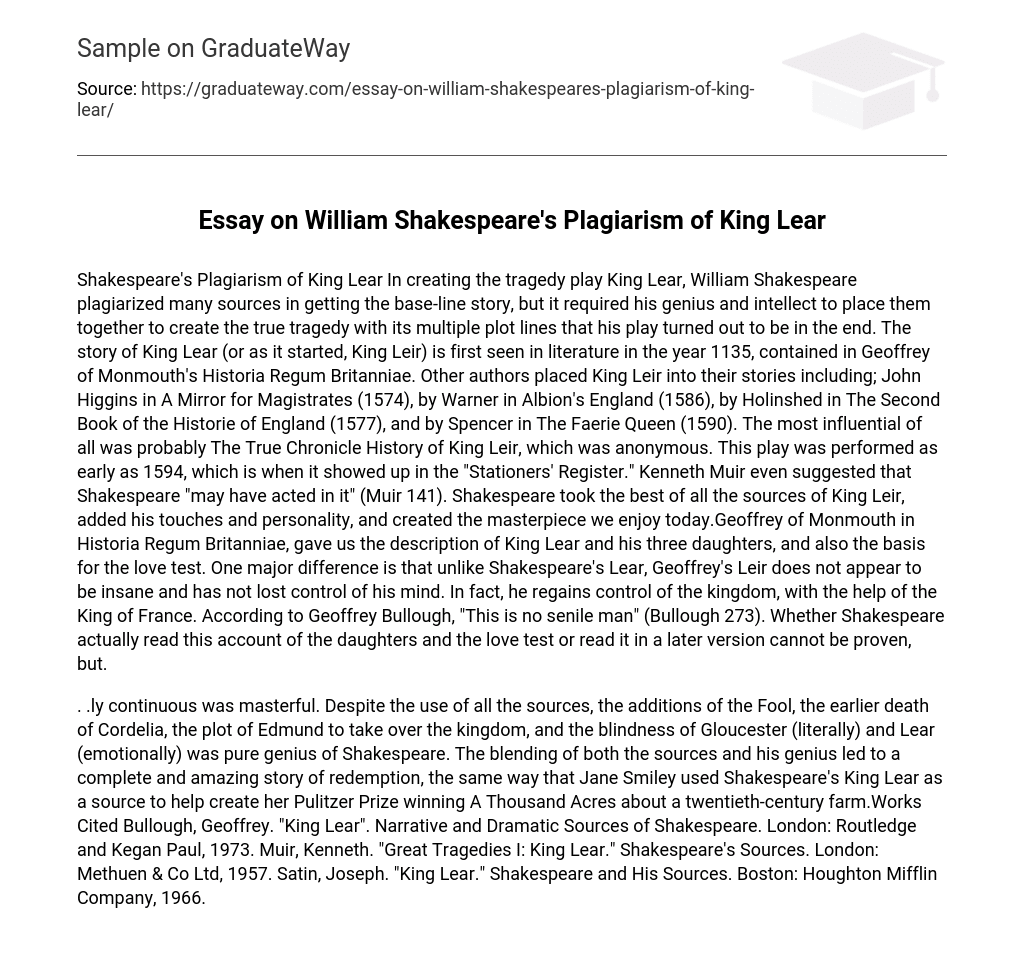Shakespeare’s Plagiarism of King Lear In creating the tragedy play King Lear, William Shakespeare plagiarized many sources in getting the base-line story, but it required his genius and intellect to place them together to create the true tragedy with its multiple plot lines that his play turned out to be in the end. The story of King Lear (or as it started, King Leir) is first seen in literature in the year 1135, contained in Geoffrey of Monmouth’s Historia Regum Britanniae. Other authors placed King Leir into their stories including; John Higgins in A Mirror for Magistrates (1574), by Warner in Albion’s England (1586), by Holinshed in The Second Book of the Historie of England (1577), and by Spencer in The Faerie Queen (1590). The most influential of all was probably The True Chronicle History of King Leir, which was anonymous. This play was performed as early as 1594, which is when it showed up in the “Stationers’ Register.” Kenneth Muir even suggested that Shakespeare “may have acted in it” (Muir 141). Shakespeare took the best of all the sources of King Leir, added his touches and personality, and created the masterpiece we enjoy today.Geoffrey of Monmouth in Historia Regum Britanniae, gave us the description of King Lear and his three daughters, and also the basis for the love test. One major difference is that unlike Shakespeare’s Lear, Geoffrey’s Leir does not appear to be insane and has not lost control of his mind. In fact, he regains control of the kingdom, with the help of the King of France. According to Geoffrey Bullough, “This is no senile man” (Bullough 273). Whether Shakespeare actually read this account of the daughters and the love test or read it in a later version cannot be proven, but.
. .ly continuous was masterful. Despite the use of all the sources, the additions of the Fool, the earlier death of Cordelia, the plot of Edmund to take over the kingdom, and the blindness of Gloucester (literally) and Lear (emotionally) was pure genius of Shakespeare. The blending of both the sources and his genius led to a complete and amazing story of redemption, the same way that Jane Smiley used Shakespeare’s King Lear as a source to help create her Pulitzer Prize winning A Thousand Acres about a twentieth-century farm.Works Cited Bullough, Geoffrey. “King Lear”. Narrative and Dramatic Sources of Shakespeare. London: Routledge and Kegan Paul, 1973. Muir, Kenneth. “Great Tragedies I: King Lear.” Shakespeare’s Sources. London: Methuen & Co Ltd, 1957. Satin, Joseph. “King Lear.” Shakespeare and His Sources. Boston: Houghton Mifflin Company, 1966.





